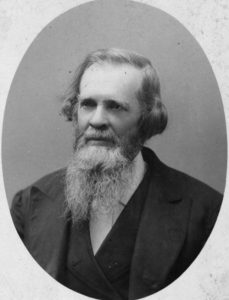 REDWOOD
REDWOOD
Sequoia Sempervirens
“For they sing to my heart,
And it sings to them evermore.”
—J. P. Lowell
Albert Kellogg (1813 – 1887), a physician and botanist, wrote the below essay at the end of his book on the redwoods. Kellogg, a founder of the California Academy of Sciences, was much less pecuniary than Cherry, and less concerned with the business of harvesting redwood. He was absolutely fascinated by the beauty of these magnificent expressions of nature, overwhelming his scientific eye. In the essay, Kellogg begs for some sort of policy to protect these forests, in contrast to Cherry’s urge for accelerated exploitation. He argues that these forests have enormous value as filters of air and water, and perhaps other unknown (at the time) “beneficial effects alone to warrant the utmost concern.”
Kellogg’s remarks were the start of a campaign that built momentum slowly over the decades. John Muir wrote in 1920,
Any fool can destroy trees. They cannot defend themselves or run away. And few destroyers of trees ever plant any; nor can planting avail much toward restoring our grand aboriginal giants. It took more than three thousand years to make some of the oldest of the Sequoias, trees that are still standing in perfect strength and beauty, waving and singing in the mighty forests of the Sierra.
Albert Kellogg was a friend and co-founder of the San Francisco Academy of Natural Sciences with William P. Gibbons. Kellog would not donate his manuscripts to the Academy near the end of his life.
ESSAY UPON REDWOOD
Specially written for ” Redwood and Lumbering in California Forests,”
by Dr. Albert KELLOGG, of the California Academy of Sciences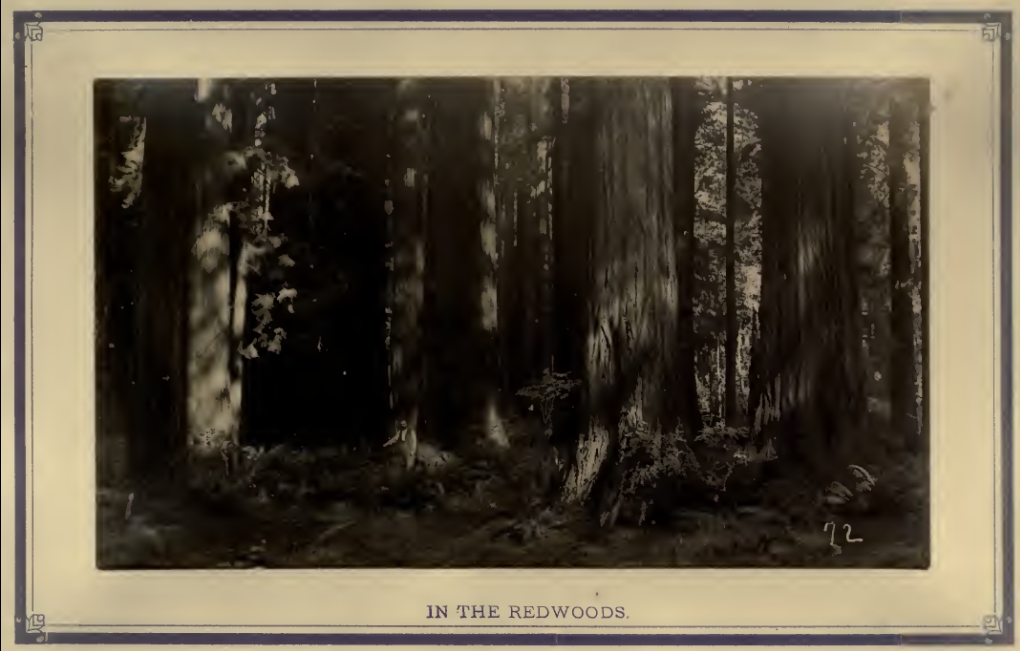
Confronted by a Redwood forest, our powers of adequate description pale before these mighty monarchs of the far western wilds gloaming mountain slopes, rich river bottoms, or marching in solid phalanx adown the deep glen so dreary; anon, striding, another Atlas, up to heaven’s gate, they challenge the stormy height, as it were, careering under bare poles, whilom chanting sublimer patriotic songs “For our flag, it was still there!” Who can duly appreciate all their mighty magnificence, mounting up among the thick boughs, where also the eagle maketh her nest on high, the bird of freedom gathereth under her shadow! all the grandeur of their vast dimensions dimmed by distance, whether we look towards the lofty empyrean or far away after their high horizon! Redwoods of most enormous proportions, 200 to 350 feet high by 10 to 20 feet or more in diameter, towering the grand trio! sentineled our entrance of the Golden Gate in August, 1849; they then also lined the immediate Pacific Coast of California, from San Luis Obispo or near the northern boundary of Mexico to Oregon; here and there vanishing inland altogether from view. Note their clean and elegant trunks, Grecian pattern, cinnamon-red bark, fluted, as the deep, swift water moveth without let or hindrance, 75 to 200 feet of sheer shaft these, in brief, were our lofty landmarks, objects of intense interest; for they were the great colossal characteristic evergreen emblems of laudable ambition, and our golden goal! bold! nay, sublimely awe-inspiring! mighty monsters, these most imposing herculean pillars of the heavens, from out whose blue vault they looked abroad o’er land and sea, high above the hill-tops beyond the Bay, bearing ever aloft triumphantly freedom’s golden crown, responsive to the last lingering rays of the sun, as he sinks to rest in the western wave! Alas! what wits it now to us to know whether they saw the Vandals, or the Vandals saw them!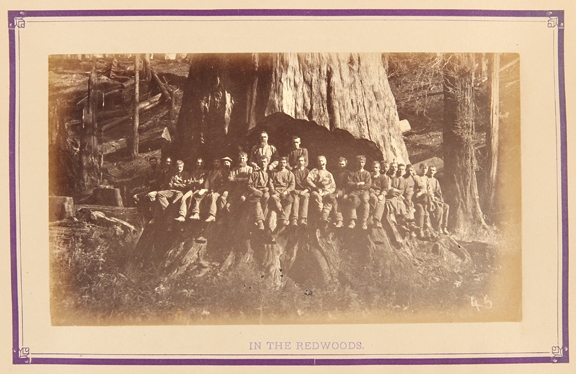
Viewed from these higher interior summits, redwood forests are full oft, in their season, overwhelmed in a billowy sea of watery atmosphere, so perfectly immersed as to quite equal a light rain, or so permeating with wet, that even shelter above is vain; hence these trees are transiently obscured, and more commonly of a summer’s eve altogether lost lost, until the thick fog lifts the following day. In order to realize this scene in some highly appreciable sense, one should take somewhat of a bird’s-eye view of it at a distance; and although charming at all hours, declining day, or best of all, in early morning at 10 to n,when the slant light strongly defines the lights and shadows on the denser low dutch, tumuloid, tumble-down sort cf fog-clouds, as they “roll in at the Golden Gate,” or crowding up over hills, flowing down dales, slowly filling deep gorge, wild wood and wider vale here and there
in a hurry anon, stealthily as the cautious Indian, reassured, they emerge from out embroidered foliage, surprising one as an apparition, pale and gray as a ghost from the shades! comfortably, afar off, as it were on dry land, this eternal drip is not so annoying to contemplate! On our high places, spell-bound, one may sit for hours in pleasant reverie, watching the changing, billowy abyss. Soon the cambric night curtain lifts, and vistas of grandeur and of glory, beauty unwonted! and still they rise, refreshed and charmed as a morning bride in her vail: but to dwell on these ever-varying visions would be to write an endless volume!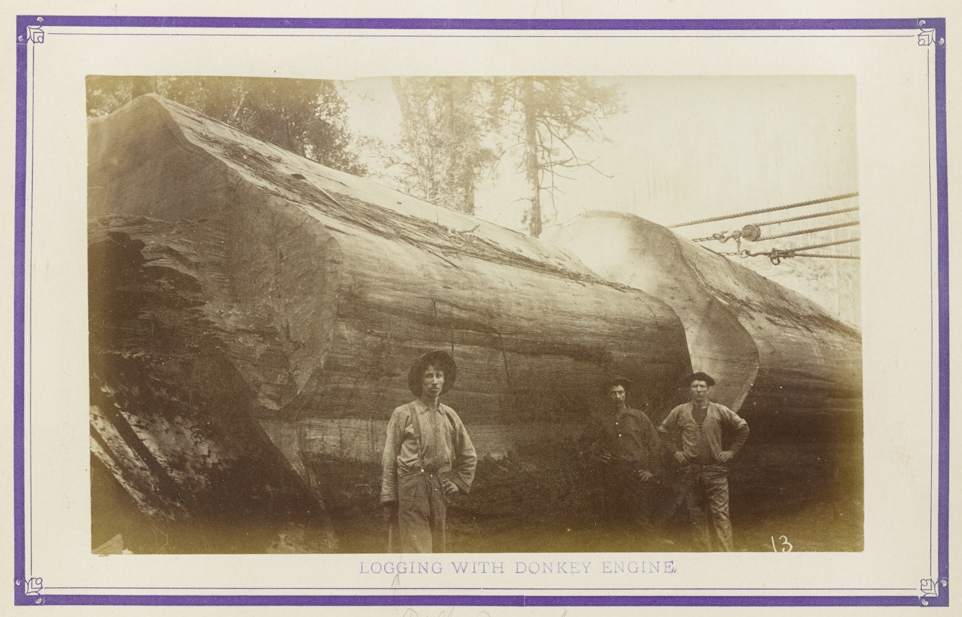
Suffice to say, our redwoods are only found within the limits of these frequent fogs, five to fifteen, rarely thirty miles inland, and probably never beyond forty, even in the most favorable low portions of the coast, where fogs pass unobstructedly through open gaps and freely along the lowland vales. These majestic John the Baptist Cedars seem to possess a magic power over passing fogs, precipitating them, and as it were, sprinkling with a continual rain the loose ashy earth, or usual sandstone soil at their feet: strictly speaking, rainless earth-clouds are they, from on high; nevertheless, distilling a continual supply to replenish living springs of the purest waters that ever bubble and babble at the charming redwood’s bidding; they are therefore choice guides to, and guards around, the purest fountains and general water supplies of the Coast Range wilderness; but for this very reason, most lands are apt to become too miry beneath them for public highways and private avenues, and for rural retreats they are altogether unfit.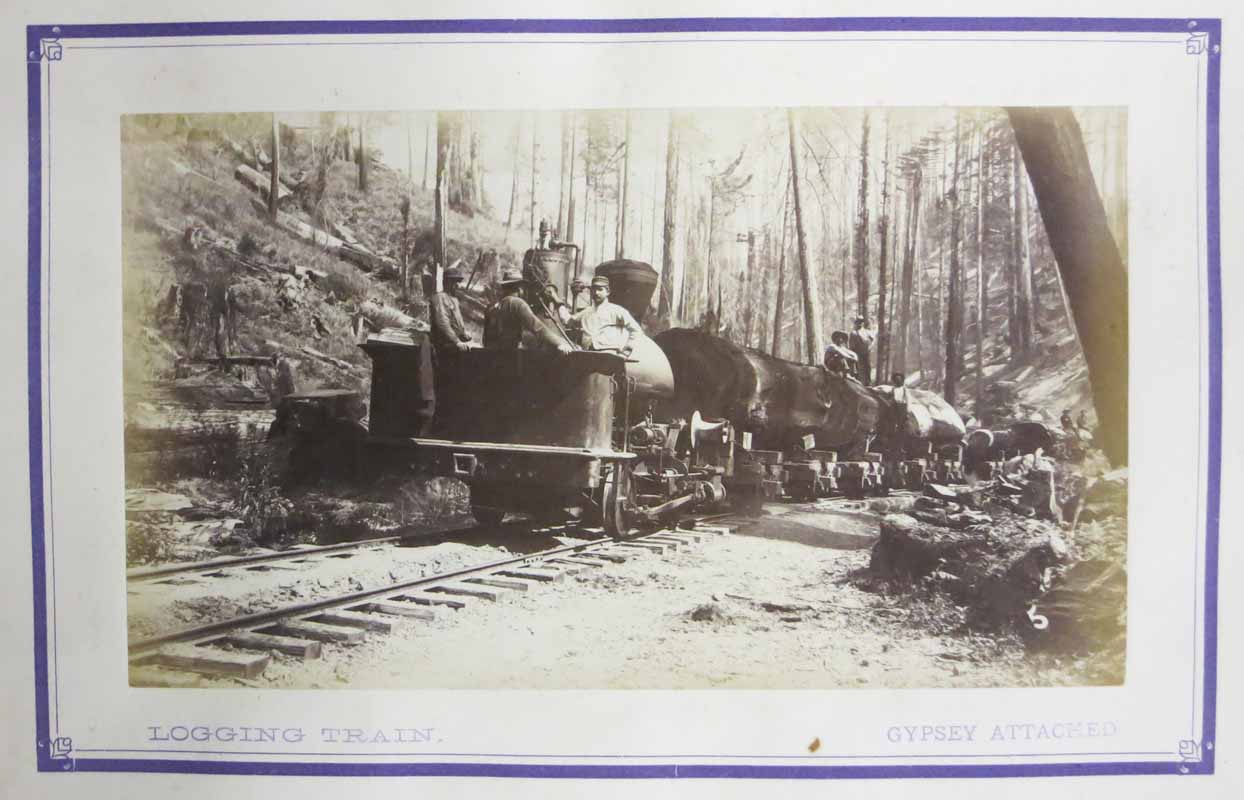
The numerous branches are small and very short, relative to the huge size of the body; in age they become quite insignificant, as it were mere appendages, so intently devoted is this Redwood Cedar to the all-absorbing timber-producing purpose of its great sylvan tower; this enables them to close their ranks, and crowd the land with an immense amount of timber per acre, in some rare cases from i to 3,000,000 feet millions absolutely unparalleled, save by its great Sequoian kin of the Sierra. This species, therefore, is only second to the Giant Washington Cedar of world renowned fame; and like that, too, the redwood attains to thousands of years of age! and what is even more marvelous, the monstrous stumps after the tree is cut down and one would suppose utterly destroyed even at the extremest age and size, still they maintain their original vitality, for they forthwith shoot up unnumbered saplings of great vigor, and exceeding rapidity of growth; only continued repetition at brief intervals will kill them. It is this sprouting from the stump and parent roots, like the olive, that forms those social circles within the usual area of 30 to 46 feet or so; when thus renewing their youth in such close proximity, two or more may unite to form one large tree. Realizing types of loving fables, and lasting friendship both of classic and legendary lore these, though not apposite to our purpose, yet
“Oft we hear their soothing voice
Low whispering through the shade.”
From this it will be seen that the timber-supplying capacity of a redwood forest, under judicious care, is so prodigious as to seem almost incalculable, because illimitable.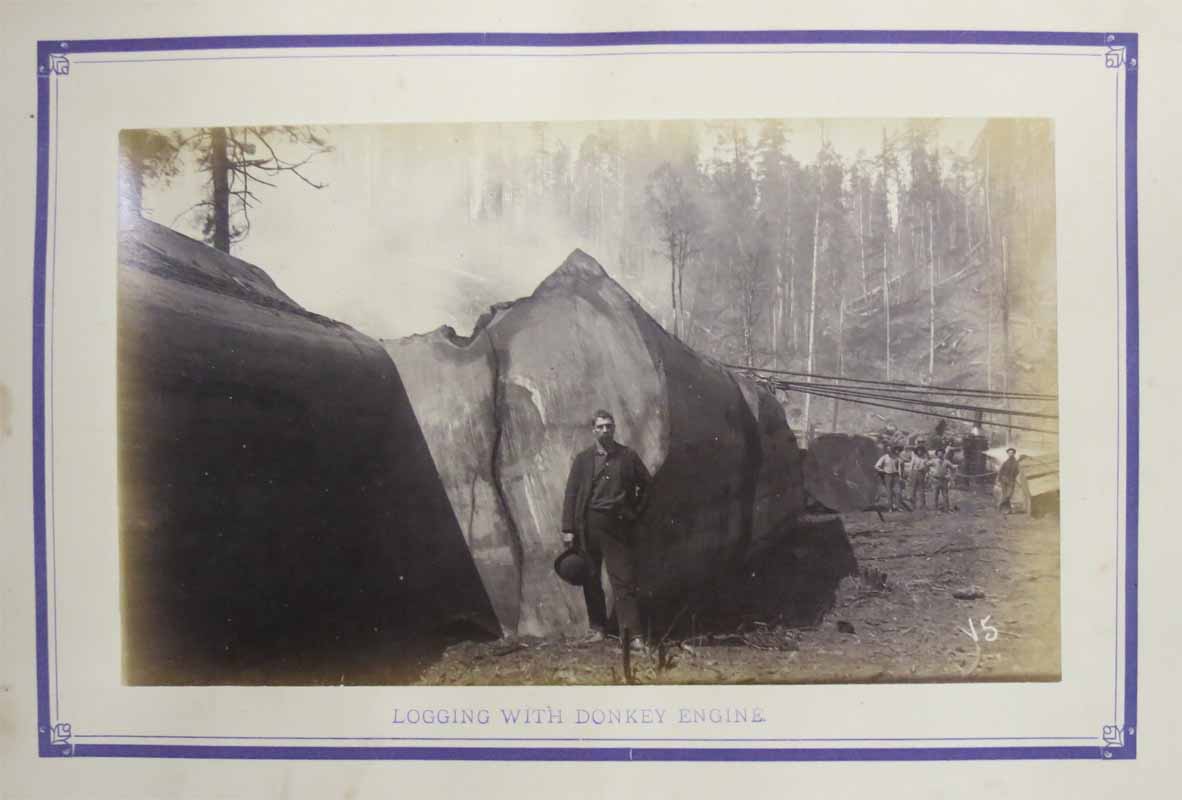
We say “care” because only at this juvenile age can fire harm them; also their daily fog-condensing foliage referred to renders them, for the most part, almost forest-fire proof; at length, with age, what the damp woods lack to absolutely hold in check, the ‘forest fire-fiend is supplied by a most peculiar kind of red or cinnamon-brown bark well worthy of a study consisting of a thick coating of light, porous, readily shreddy-fibrous, lamellar mass of coarse-satiny substance of a dry, peaty, silicated texture, without even a vestige of either oil or resin, so common in other conifers, or to their renowned and sacred kindred of the old world; is apparently dry of substance, if not of surface, and so nearly fire-proof as to simply smudge and apt to char superficially, so that it rarely heats to injure or to kill trees of a few inches in diameter.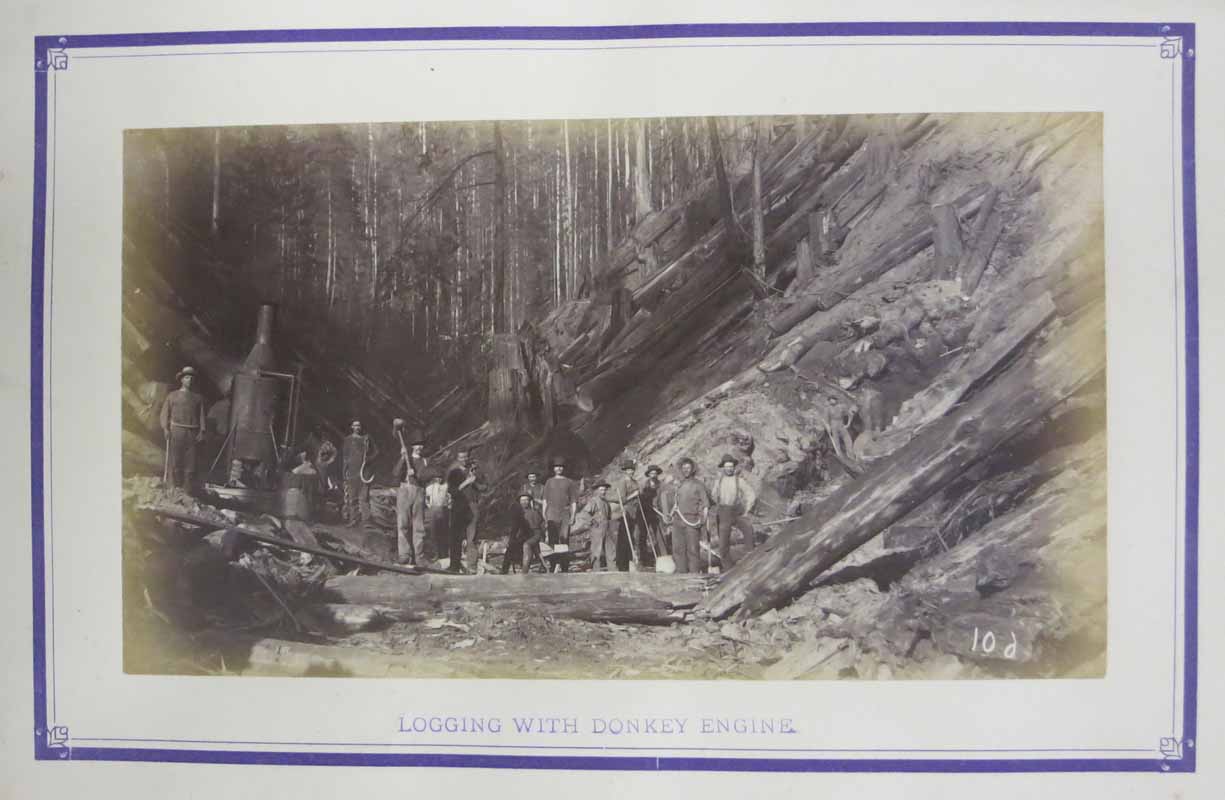
If, however, it does penetrate deeper, and burn for a long time, it seems not to kill the thin, paper-like layer of living bark beneath. It is also a notable fact of general repute that might be mentioned here, that a somewhat similar resistance appertains to the timber: houses built of this wood are not so combustible as those of pines and other large constructive joinery; broad surfaces of it always fire with difficulty, and the slightest dash of water quenches it quickly, like the suddenness of a puff on a candle blaze. Consequently, for this, and reasons herein after given, most houses are built of it in California. But returning, the bark of redwood ought to be better known but as yet, it has but slightly attracted public attention almost utterly going to waste; nevertheless, it has manifold properties, and uses unnumbered; its magic dryness in the midst of mire and moisture is something amazing and to bridge over by a safety coating against wear and tear, and to facilitate easy transit of great weights over bridges and rough roads manufactured into upholstering or mat material, etc.; summarily, it is safe to say it would in one way or another meet a thousand wants. But the reader must accept general and suggestive hints his own thought will supply the rest. Let us pass on to consider those uses already known or soon to be more fully utilized. This course is too often forced upon enunciators by the popular plodders like ourselves, who are most of all wont to enter into other people’s labors; albeit we turn again and read with ridicule our antecedent and best benefactors. Why so ? forsooth lest the firm of ” Proud Us & Co.” be under some obligations somewhere in the universe heavens above or earth beneath. But whatever judgment posterity may pass upon the men of this day and generation, we seem doomed to be” famous according as we have lifted up axes against the thick trees.”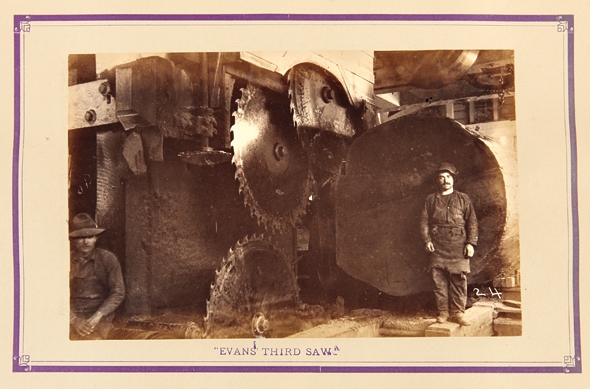
“Redwood” Yes, for the wood is red, with a faint, coppery, or metallic iridescent gloss; and so also is the bark, as above mentioned hence the appropriateness of the common name. As a general remark, the grain is true to a line, and splits with amazing precision noted for thus making timbers and ties, rails and pickets, shakes and shingles by annual millions. In this species ” redwood ” (Sequoia sempervirens), the leaves are like the yew, spruce and cypress, that is, small, half to an inch long, a line wide, and line-like, with a prickly lance or awl point, of course, distinctly arranged in two rows; rather dark, dull green above, the under-side soft, grayish green; this two-ranked character of the flat, final, starry spray of tiny twiglets, tipped with the first young growth of spring, is of a bright and even vivid yellow-green verdure, as tender and listless in its repose as an infant on its mother’s bosom! Yea, for gaiety of beauty and for grace, these branches excel the choicest flowers and prettiest ferns; reminiscent of the charming Spring spruce groves eastward, redolent of Eden odors! But for grander display in this Spring state, and in every other way, these thrifty young redwoods exceed them all. Somewhat mixed with the common foliage are always to be found some spaces of leaves reduced to mere scales; and occasionally a few trees in every grove have altogether awl-pointed, tiny, scaly leaves, similar to the great Celestial Cedars of the Sierra Nevada mountains.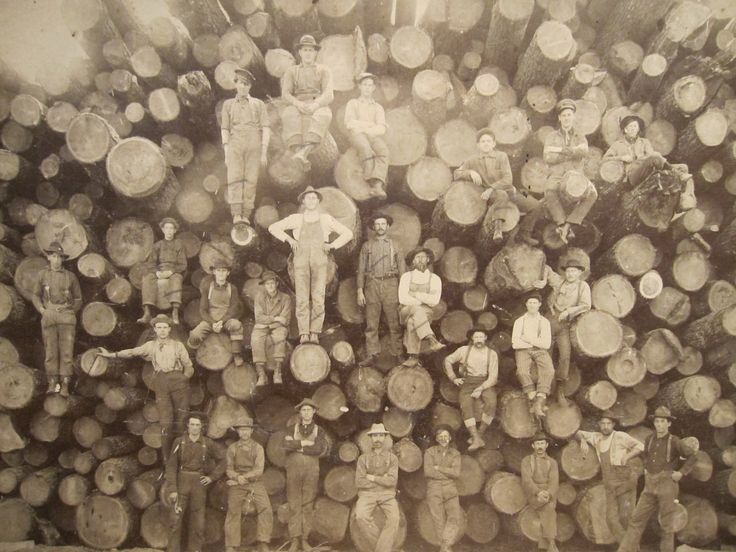 Although we have observed that these garland-like limbs are chiefly spreading, nevertheless, like all conifers of weak and slender branch, in great age, they too are apt to become more or less tent-topped, especially as tipped and gracefully drooping, with male flowers, like their mammoth kin; or pending, tiny, terminal cones of an oblong shape one to one and one quarter inch long, and one half to three quarters of an inch thick. These numerous trapezoidally disked scales are thick and roughly implaited by the indrawn or quilted-like center; this shield-like disk is not only thus puckered in. but marked distinctly by a sharp, laterally transverse ridge stem of this scale stout, compressed, broadly wedge form, with some sharp angles, persisting, covered and stained by a dark purple, almost black, shining, fragile and granular secretion, like Gum Catechu (tannic extract of an Acacia), of the apothecary. Seeds, three to rive to each scale: flattened oval, or obovate in outline; the lateral wings very narrow, or slightly and often obliquely margined; color, dark reddish brown; only a little notched at the outer and larger end altogether shaped like parsnip, or other similar seeds.
Although we have observed that these garland-like limbs are chiefly spreading, nevertheless, like all conifers of weak and slender branch, in great age, they too are apt to become more or less tent-topped, especially as tipped and gracefully drooping, with male flowers, like their mammoth kin; or pending, tiny, terminal cones of an oblong shape one to one and one quarter inch long, and one half to three quarters of an inch thick. These numerous trapezoidally disked scales are thick and roughly implaited by the indrawn or quilted-like center; this shield-like disk is not only thus puckered in. but marked distinctly by a sharp, laterally transverse ridge stem of this scale stout, compressed, broadly wedge form, with some sharp angles, persisting, covered and stained by a dark purple, almost black, shining, fragile and granular secretion, like Gum Catechu (tannic extract of an Acacia), of the apothecary. Seeds, three to rive to each scale: flattened oval, or obovate in outline; the lateral wings very narrow, or slightly and often obliquely margined; color, dark reddish brown; only a little notched at the outer and larger end altogether shaped like parsnip, or other similar seeds.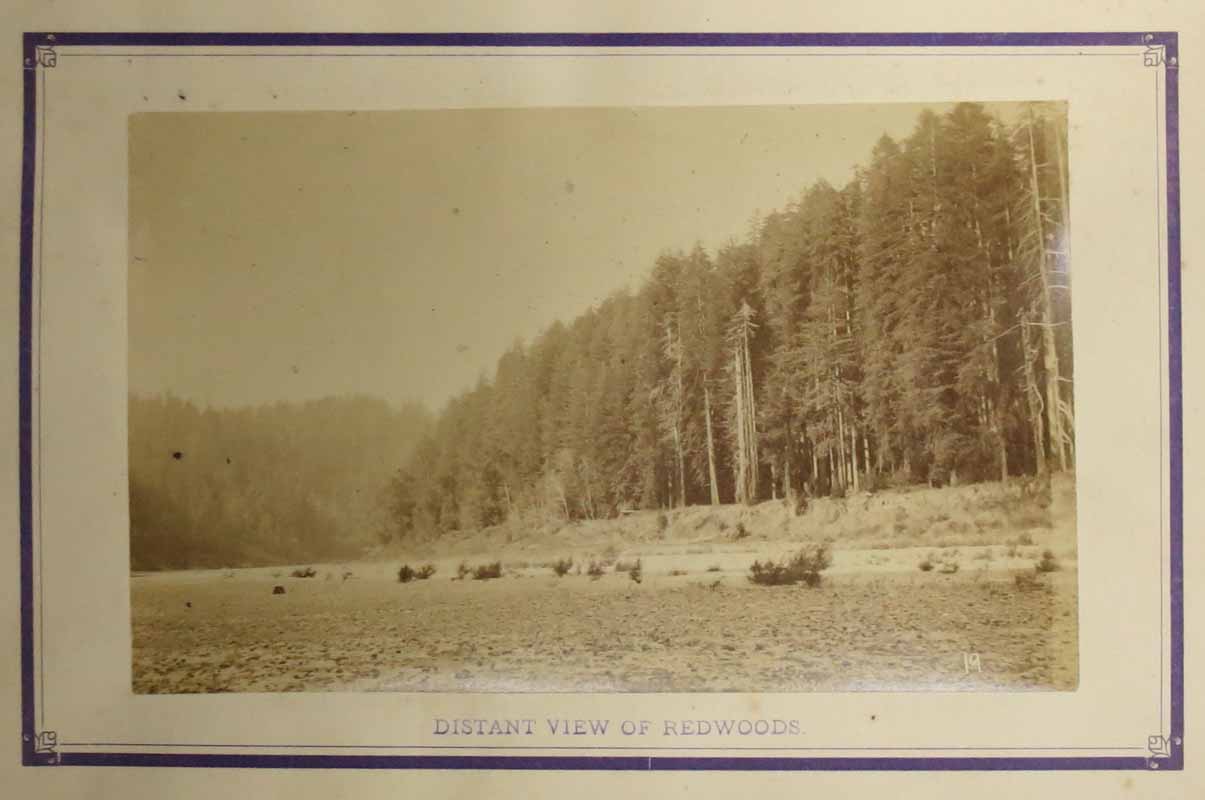
Having thus far briefly sketched the general aspect, proportions, bark, foliage, flower and fruit, here and there only a general, casual allusion to color, texture and quality of timber, some few details and associative remarks must close the natural history of this other great tree-wonder of the western world. True, some of this timber is marked by bluish, iron tinted, or dark and almost black seams, with varying shaded clouds that curl the glossy, highly finished surface; but the prevailing hue, as observed, is reddish in both species of Sequoia, the best proportions of which are scarcely less durable than the underlying rock foundation upon which they flourish.
Vast stumps ten to twenty-five feet in diameter, often twenty feet high, where the chopper’s scaffold is usually constructed for the felling notch, especially where the best of these abound of Humboldt, Elk and Eel sections north the more immediate basal body-sweep of root-spurs of the higher and dry land timber would yield an immense amount of the choicest ornamental curled lumber in the world, scarcely less valuable than all the other parts of the tree put together. There is, therefore, more left and lost than is taken and gained by present methods as will better appear further on.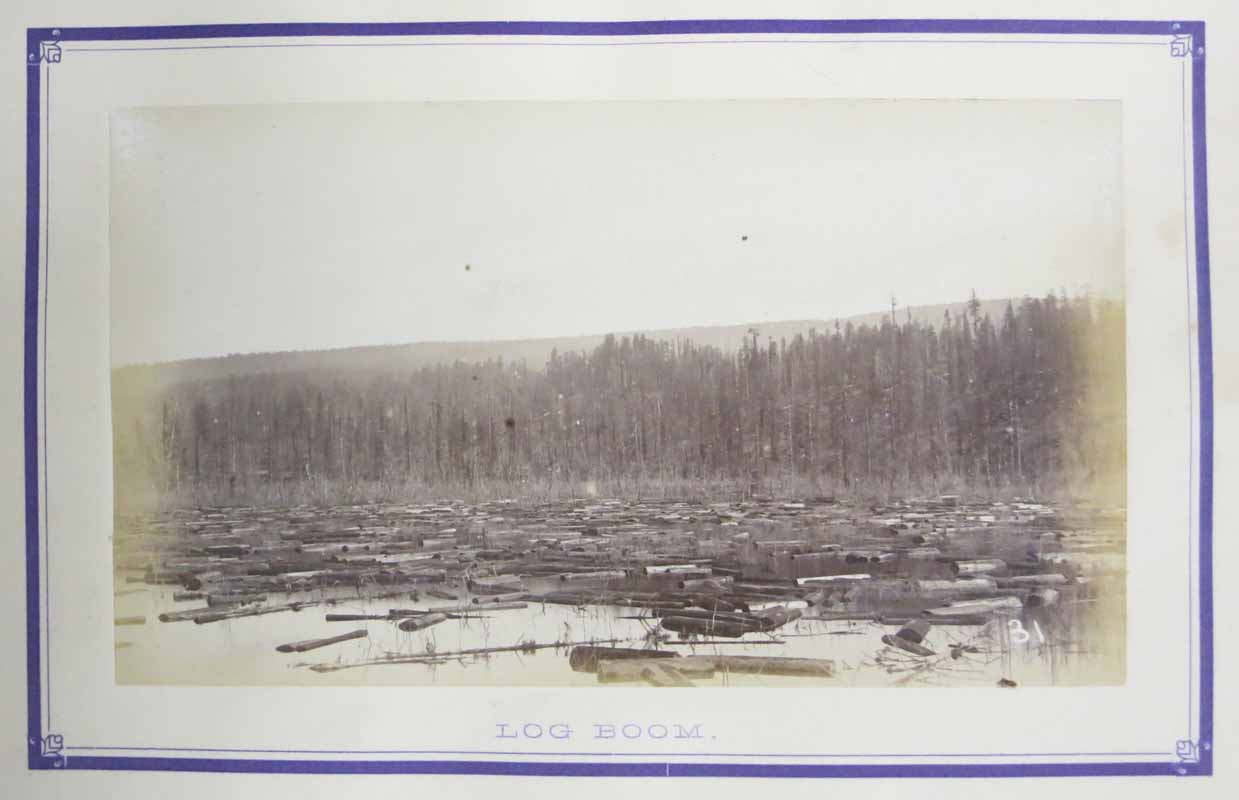
Let the reader please consider we have almost two million acres of redwood soil intact, or scattered and partially despoiled but if half or a quarter of that, what a ruin is spread around and lost!
With access to tide water great economic value universal uses scarce a remote rival an all but imperishable cedar! It cannot be urged that the commerce of the world has no demand for such invaluable timber. The most plausible excuse that occurs to our mind is, that enterprise and capital have not been called to it. A great”deal” of such fine cedar-wood ought to find its way into foreign markets, like similar conifers of far less value from India and other parts of the world.
Another point, perhaps the more worthy of note, because it seems so inconsistent with a preceding statement of the very perishable nature of some parts and sorts of redwood, or conditions precedent to use, viz, in regard to the more brittle, homogeneous, soft top, portion referred to which, in the recently cut timber, is, to a great extent, not to say entirely, rejected as refuse or only a trifle here and there used as indicated.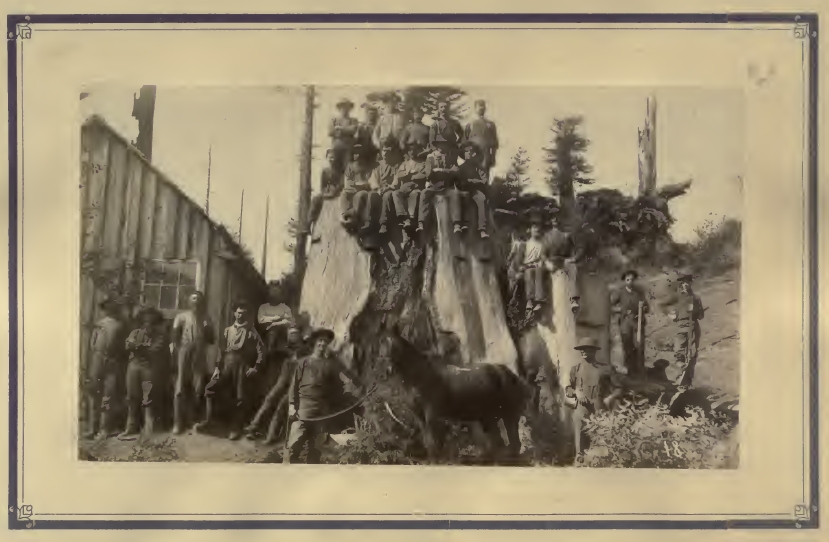
But whenever the storm splits away any of these tenderly brittle tree tops in their living state just at this apparently poorest portion, they slowly season for ages; and yet it often seems only as an accident of yesterday, so fresh and free from decay are they! (albeit some perish when the soil itself is at fault). Here, too, is the favorite lofty watchtower of the great “Imperial Woodcock” (Campephilus imperialis] that haunts the lonely dell,” here, too, lie rolls his loud love-call *** far through the hollow wood-lands resounding! Or, perchance, the wary sentinel, perched upon these high places of the far western wild-wood listening,
“Deal,” be it noted, is the old Anglo-Saxon for “dael,” a piece of wood German “dicle,” in early times a piece of wood riven by a “deal-axe,” or froe and still this and other like free-splitting timbers are the sylvan joy and blessing of the early pioneer.
and intently looking, his keen and curious eye descries the enemy! Anon the tell-tale telephone sounds the alarm * * * soon, too, he is gone the way of the distant and scarcely audible answering echo of his mate. Anon, the leaves begin to fall, and the early shadows to decline.
Conscious of the low, charioting, wind-waves as they begin to roll unwontedly along the forest foliage, louder sounds from afar off, borne upon the fragrant autumn breeze * * startle and begin to disturb the long silence of his serene abode; and in ways unnumbered and unknown to man, oft from his lone tree-top he tells the sad tale of an approaching storm, cautions the trees, and those to whom they correspond and represent, to beware!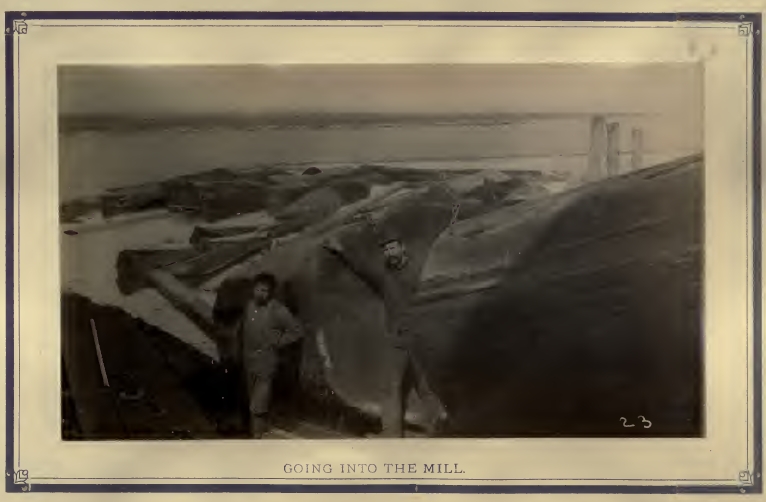
Or, putting question or query more intelligently, as seen in the light of right reason and due reflection and is it possible to avoid the conclusion that storms also proceed in a trinal order, from end, cause and effect conditions prior, posterior to postreme first, middle, and last or in its own elemental series from primates by intermediates to ultimates? or with any other dress your own idea of thought may choose to clothe it hence physically prophetic tests of the Government Signal Service, or Weather Bureau! or those other finer and purer telegraphic and telephonic animal nerves or excitive vegetable fibres to become all astir preparatory; or higher still, gifted humanity! May they not then, together one and all, sense the coming storm? and in many cases not only feel, but perceive, see and hear as we have heard the coming raindrops in the preceding wind if you please, hours, days, nay, weeks before it came, defacto. Now these aural with ethereal rarer and less rare to condensed watery material, are alike substantial, and as such, tangibly sensated the one of the same or similar form and nature as the other, purer or grosser, and so, prophetic by law, aural, magnetic and aerial clouds and storms are to some extent, and ought to be generally, recognized nay, solid, metallic, meteoric and earth storms, too, included!
And be it known, these greatest, tallest trees, aspiring to serener realms above, beyond their watery, cloud capped summits, have also their great forest-loving Weathercock of the Wood for a use. Among sundry and divers other fall forebodings nay, the never failing forerunner of the wintry storms of the far West, we behold the great presaging Pacific swell come rolling in, and lifting up a mightier portentous wave, breaking tumultuous along the sounding shore! rampant, the surf’s roar is borne higher on sonorous wings of a clear, cool, and more humid autumn air resounding far over dismantled highland hill, re-echoing the great Coast Range crest! ever and anon louder wave-tones emphasize mine ear! And why not they, these, and those other signs, impress all animated nature as well! Even so, let his imperial highness, the fiery-plumed knight, go his wont aloft to picket the lonely outpost climbing his pinnacle of fame the majestic redwood rampart rolling his wild reveille; while the sweet little water ousel warbles her feminine song beside the pure brink sheltered beneath the green shade at his feet! Testing this resonance on the fallen tree, listening, methinks I hear the soul of the viol pining, imprisoned or anon the silent harp wakes the long slumber of the ages!
“Let not this harp neglected lie, awake its silent strings, And spirits from their depths will fly, with music on their wings.”
Few of our readers can realize the great loss by smashing up at the tremendous fall of these giant Cedars, as they plunge headlong, thundering down the dark forest and deep glen, spreading ruin broadcast, as seen everywhere, save where so soon as possible it is burned out of sight.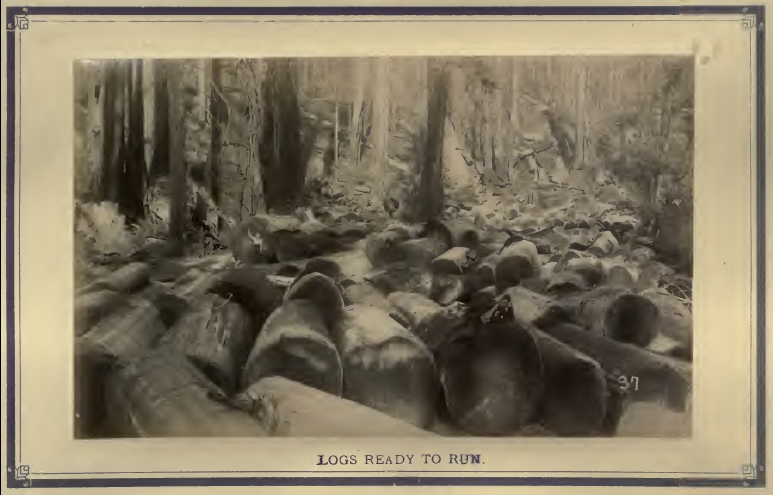
As for any graded uses worthy of the name, either of the upper lighter, or lower heavier parts, or for fuel, these and many other economics are unheeded, if even heard of; yet Cipon these wastes it is not so much our purpose to dwell, although we may refer to them time and again. Moreover it is pertinent to any forest, to make a passing remark upon its local and general climatic influences and extra commercial uses, for this not only concerns us, but the most part of mankind, if not all.
We have often heretofore passed in our testimonial observations from numerous examples known in all lands, localities the most notable and close at hand, and of every clime; yet there are thrice negative minds doomed still to walk benighted beneath the mid-day sun, themselves their own dungeon, with evidences clear as day all around them, evidences of the manifestly injurious effect of indiscriminate and heedless forest denudation : of course, this is not the place to present such vast arrays of proof; we can only affirm what every tyro knows; the drying up of springs, streams, wells, and water pools, yea, sweeping away every vestige of vegetation, robbing and devastating the power of future production, and even banishing the very soil itself! Why not, then, place these forests under specific and provisional lease for a term of years, to revert to Government, State or National, to be again protected whilst the remnants and roots are recuperating the dismantled forests; and the more so, seeing all are agreed that an enlightened public policy requires it?
Among many, some may differ as to the extent of climatic and other influences, such as arid, bleak, irregular, or variously impoverished wind we use this expression advisedly in manifold senses because, for aught we know to the contrary, forests as vast alembics may filter and purge, purify and exhale much invisible, and so to speak, aerial and highly fluid food upon the bosom of the breeze, ready to be appropriated and vitalized at once, nursing, nourishing and guarding not only men and animals, but benignantly ruling at the head of its own realm, with trees of honor, from the high cedar unto the low and vulgar bramble; for none liveth solely unto itself. Thus the leaves, after drawing up and preparing such and similar pabula, then they too fall away, and furnish the grosser earthy humus, salts and soils so well known and needful to forestal exhaustion, so imminent in the natural course of growth, of culture, or of abstraction, and of waste.
May there not also be more recondite magnetic, electric, and aural influences that, at least, serve to stimulate as ample experiments seem to confirm or to compromise all the extra hypothetical and probable ? Suppose we agree to relegate the whole mystery to their known and more palpably demonstrable and mighty tempering and irrigating powers, since enough is known of these beneficial effects alone to warrant the utmost concern; and all that, super added to the commercially economic foreshadowed, or to be hereinafter more fully substantiated. So long as trees and shrubs clothe highland, hill and mountain, neither drought nor flood are likely to afflict the fruitful vale or rolling plain; health and plenty abound. Even a small belt of a few rows of trees serve to intercept malaria, when filthy fen and swamp are left undrained; but cities and nations, numberless for multitude, have been made a barren waste and depopulated by the removal of their trees; anon, restored by their planting, or their natural growth. Yet in Egypt, where no rain often falls for a whole year together, Mahomet Ali, by planting trees, caused an average of thirty rainy days in a year! Our own personal observations of instances, although not so historically authoritative, would fill volumes.
The preceding general remarks give us in outline, for the most part, the principal characteristics of one of the most wonderful, and at the same time most useful, of all the timber trees of the known world. These two Sequoian Cedars maritime and alpine -seem to embody, combine and concentrate more durable and available timber material to the given area of land occupied, than any other genus of trees hitherto discovered; or one to two million feet to the acre.
Let us, then, return and review the manifold points of practical consideration in order more fully to confirm the truth, and obtain some proximate, realizing sense of the subject.
We have, in some sense, seen that for health, vigor, longevity, phoenix-like vitality of rehabilitation, and only less than perpetual durability, at its best; and, as we shall further show presently, that they stand pre-eminently unrivaled. To this end, we must appeal to numerous collectors of facts and figures set forth by the most reliable local writers, together with the best results of applied workers at home and abroad, in all departments of those uses for which this timber has been commended. As we have before suggested more careful choice of quality, and as this also greatly depends upon judicious sectional selection as for example, the lighter softer, more homogeneous textured, that neither expands nor contracts with varying humidity, from the higher off-coast of Humboldt regions; so for the harder, stronger, less fragile, from the nigher coast middle region of Mendocino southward, must need be well chosen for given purposes indicated. It must be confessed that little has ever been done in this line as it should be, to do justice to any timber whatever; but besides this more northern and relatively sheltered Eel and Elk River region, groups, groves or specimens anywhere in higher, drier soils; as the wood is well matured, or, so to speak, ripe, the uniform testimony is that it makes the best timber. Now, the experienced and observant woodsman will readily select for you many such choice trees in any locality where they are found at all; but it is not always easy or practical for him to communicate this art to wiseacres, and he is generally too sensible to talk tact to a tyro among the trees; or even with the very best intentions, kindliest inclinations and efforts, very little tree-lore will ever fall to the lot of us inland lubbers amongst this sort of lumber or indeed, thorough knowledge in any branch, uninitiated. Nevertheless, if the top-leader of a trim and shapely tree has been snapped off in years of yore, and is still sound as a bell as it is most sure to be, so long as the main shaft itself remains alive it is proof positive of prime stuff throughout. Could this, by arrested growth, so operate as a cause of quality ? Or is it not rather the result and evidence of a tenderness of texture too delicate to withstand the tempest ? Besides, when this sort of trees reach three to three hundred and fifty feet, stiffened and cranky by size and age, the sway in an ordinary breeze is even then several yards at top, and in a storm, such an all powerful snapper, no timber over-ambitious of its neighbor, can stand.
The writer, many years ago, in passing through the redwood region of Humboldt and Mendocino Counties, surveyed these forests in their primeval grandeur. 25,000 feet to the acre of outskirts to 50,000, or even 80,000, is officially given by the Government; but if fairly taken off in any foreign or best civilized European sense, the yield would reach more than a million, if not even two million feet of timber to the single acre of well selected areas; true, only 96,000,000 are said to be shipped to San Francisco annually. The lowest estimates now available and these, of course, only conjectural, as to the amount shipped to foreign ports direct from the mills some put this as low as 35,000,000; but as we export redwood now to nearly all parts of the world for example, to Peru, Mexico, Honolulu, Australia, Tahiti, Chile, Central America, Europe, Asia, East U. S., Siberia, Japan, Panama, Marquesas, British Columbia, New Zealand, and elsewhere, with thirty to forty large market mills with at least twice the capacity reported, it must be simply immense. Although placed at 131,000,000 in all, it can scarcely be doubted that it is nearly as much more. Neither do those figures include the small mills for local demand; lower, best butt logs or sinkers, which are rejected, and left with stumps and tops on the land. Also, for obvious reasons, the reader will readily understand that where private interests lie in the line of concealment from the public, on account of combinations, those ostensible figures given are rather more liable to be under than over the actual truth.
Trees exhumed from dry gravel, and sandy or loamy soils, or washed out in the ever-deepening valley drains of the hillsides of the peninsula around San Francisco caused by dismantling the hills of their rain-detaining trees, shrubbery, etc. these fallen trees, as observed, have been frequently found perfectly sound after untold ages. Indeed, nothing is more common than to find enormous prostrate trees under the most damp and trying conditions of our foggy-coast forests.
Writers give unnumbered examples like that reported in a recent number of the “Rural Press,” briefly: “F. R. and A. J. Hooper, of Trinidad, in 1852, whilst building a railroad, were obliged to fell a redwood tree one hundred and fifty feet high by ten feet in diameter, which had grown from seed fallen upon the top of an ancient ancestor. Roots ten inches in diameter had grown, over spanning the fallen tree, which was still sound, and furnished stringers for a trestle.” Yet in similar conditions of the self-same forest, some firs and oaks rot into fragile masses, that will crush and fall away beneath your feet, in five or six years. In both species of these reverend cedars we see immense old heart-logs spanned by the roots of living trees trees of centuries agone; and yet even now they afford the most select and choice lumber to be found. We say “choice,” because the recent wood is often too light-colored, whilst this is darker stained with age, beautifully tinted and shaded; curled-grained pieces abound in these cases, made and provided for the handsomest ornamental cabinet and similar purposes certainly equal to the best mahogany. We may safely say we have never had the good fortune to see any mahogany that for beauty would favorably compare with it.
In passing, it is worthy of note that such lumber is not *so subject, if at all in any appreciable degree, to that irregular shrinkage which is apt to mar the smoothness of the surface of the middle and more southern coast timber. We allude to the soft, cellular inter-spaced portions, so to speak, between the grain, shrinking away from the harder, horny portions of the wood, thereby roughening it into ridges, and spotting the finely dressed surfaces during age and exposure. But the defect of recent green-cut redwood by no means impairs the strength or durability of most of the timber from middle and lower sections of the Coast of California. This timber is cut all the year round; nor, so far as we are aware, does it seem to make much difference in what moon or condition of sap the trees are felled. At least, we believe it is conceded on all hands, that no insects, to speak of, ever molest the living trees, nor none the matured heart-wood when cut. This is all the more surprising, because the wood has neither the resin of pines, nor the usual oil of other cedars. However, there will be some open questions for wiser governments, or able and worthy, probably some self-sacrificing scientist of the future, to determine.
No unqualified statement in a general way can be expected to cover all cases, as we shall try to illustrate more fully in the sequel; but as board lumber it is classed with the soft and light, also liable to split if carelessly nailed. Choice curled-grain lumber takes a fine polish, and is very ornamental for cabinet and fancy finishing, and a thousand similar purposes; as simply stained or only varnished, it is found far preferable to paint; these variegated, grain-sheened, and delicately toned hues deepen to richer and darker shades with age of these we shall treat more at large in our concluding detail. The well matured heart-wood of the base of these trees is so solid as to sink in water hence designated as “sinkers;” * also as” butts,” that is, for the few” first cuts,” as the logmen express it. These will last for ages under the most trying circumstances, like the best cedars and yews, as unnumbered examples would serve to show. Yet timber taken from the upper part of the same tree may prove perishable, or far less lasting; and notwithstanding it is softer, light and brittle, is well suited for sheltered or inside work; takes paint readily, or, as observed, varnished, is finer still; and, what seems quite remarkable, no insects ever trouble any of it. From these observations it would seem to be a great error, too common, to judge of or choose timber by name rather than by selecting the proper quality.
The best practicable test for the purchaser in the lumber market is the weight per square foot, board measure.
Redwood logging, from its peculiar topography, has been greatly changed of late, on account of the expensiveness by loss and otherwise, by steam, railroads, and horse or cattle track tramways affording greater facilities and cheaper transit.
Redwood ranges from two to six pounds. It is safe to say, then, that timber weighing five pounds to the square foot of hoard measure will, at least, last nearly a half century under the most trying circumstances. As we have seen at Fort Ross (now of the property of Meyers & Bennet), recently mentioned in the ” Rural Press,” the timbers of the stockade, still in the ground, after sixty or seventy years are as sound as ever.
The same authority notes a picket fence now standing on the premises of J. P. Springer, of Santa Cruz, built in 1841, yet perfectly sound today. These redwood pickets, usually rived three to five inches wide by an inch thick, were driven into damp ground in a very foggy-infested locality.
Many instances could be mentioned of our own personal knowledge, although only of pioneer experience on this coast. As an instructive example illustrative and confirmative of some preceding remarks, is the case published in the “Press,” since similar. statements published by us prior; but all testimony alike will justify the public estimate put upon this timber, when duly selected with regard to quality. The case is that of a corral built thirty years ago from the timber of a single tree. They began cutting and setting stockade posts from the butt of the tree, working upwards. Now, the first posts to rot were from those of the top of the tree, and the succession of decay followed around the corral until the posts from the lower trunk were reached, and these are now sound as ever.
Our experience and observations some years ago on the Earthquake Committee, to examine the wood foundations of certain Front Street buildings damaged thereby, exhibited the folly, as stated previously, of choosing timber for important purposes simply by name. No one at all familiar with shipbuilding would be likely to make these mistakes. It is true, our own knowledge and experience is far from being equal to solve all queries with regard to this or any other timber of the coast; but, as in duty bound, we may possibly assist others towards their solution. If the question, for any reason, should arise whether the stump-spurs were equal in durability with the best heart-wood of the trunk of a chosen tree, we would not feel altogether able to answer it with such absolute certainty as to suggest to any one the utterances of the ancient oracles. Although some of our statistics are borrowed, and certain statements quoted, they are believed to be approximately correct. We know trees twenty feet in diameter there may be trees larger we hope to be able to photograph them. We have spoken of stumps cut twenty feet from the ground, because we have seen them, although at our northern limit of the forests, two to fourteen may be the range; or, at Humboldt Bay, where larger trees abound, five to sixteen, or even more. The largest board, we believe, brought to San Francisco is 13×7 feet, and three inches thick. If for any reason a larger were required, this could be greatly exceeded.
This Humboldt Bay specimen is to be seen at Kentfield & Co.’s pier, 9 Steuart Street, San Francisco. Some of the larger trees are reported as yielding 65,000 feet of lumber, amounting, at market rates, a single tree might be valued at $1,000.
Redwood really so nearly covers all our houses and outside work generally, as scarcely to leave an exception; that is, in the form of rustic, siding, batting, shakes and shingles, and even inside finish, such as tongued and grooved ceilings, and to some extent flooring, besides much furniture and cabinet work, largely; also, as wainscoting, cornices, mouldings and the like, besides an immense amount of rail ties, and all sorts of fencing in short, everywhere, when removed from great strain, or much friction, and where great durability is required. There is, also, little timber known that equals its resistance to climatic changes and to trying exposures.
But now nearing their exit – as these mighty monarchs bow their departure from the boards of the Great Theatre, we are fain to recall the sacred prophet’s divine apostrophe: ” Howl, fir tree, for the cedar is fallen!” The shocked earth doth groan and murmur her moan at the sound of their fall! Prone, and full oft crushed to the earth, they lie the lengthened ruin of a thousand years! hopeless, yet reaching out abroad; here and there broken, shattered and spread along the vale! Anon in solemn state they join the fated procession and pass away! Canst witness the sad havoc, and feel no pained interest nay, great solicitude? How shall these great storehouses of uses manifold be again restored?
Where now is the repairer of the breach into by-gone labors the restorer of the ancient wise paths to walk in ? Our German exemplars are never allowed to cut down one, like these, without planting and cherishing another! Therein we behold, at least, some small offering of acceptable incense upon the altar of justice a right reverend regard to the sacred obligations of love love to the generations of this world’s neighbors, to say nothing of the higher, ennobled and grateful duty to the ALL-LOVING LORD on high.
What if these be the timbered types and shadows of a Nation’s Day of its glory and its greatness! for the day goeth away * * * the shadows of evening are inclined! the darkening death-pall cometh down over the land! none to stay the spoiler and the waster, or say, “Thus far, but no further.” Thank heaven, there is yet left a little living hope of the root; as it were living fountains of another forest, if we no longer go to add unto our consummated crimes, misdemeanors, and shortcomings, the horrors of Sylvan infanticide! There is always a semblance of ganglionic conformation of tortuous grain, involved and apparently errant from its natural course of growth, at the foundation of every new departure; not necessarily irregular, revolutionary, disorderly, nor chaotic, in the worse sense. Similar curlgrained, bird’s-eye remains we see at every fork or branch as well; therefore in redwood as in all animate and inanimate objects everywhere and vital kingdoms more manifestly do we observe this wonderful arrangement for this conservation or modified reactive basis of vital force. This evolutionary remnant, or reserve, finds its actualized types or analogies universally existent. It is the equivalent of hibernation of worms, reptiles, mammals, etc., etc. In short, wheresoever we turn our eye, this arrest of directness of purpose we imitate by artificial scarring; seen, also, in several cypresses, and in great natural depreciation. Hence depauperation, nodulation of roots, crowding native or new soils familiar to the pioneer grubber, and so proof of this law. Young and thriving redwoods of spire-tops are sometimes seen, which would be admired for their beauty; indeed, they seldom get a suitable footing in the nursery; and planted only a little inland the chief fault is paucity of branch and sparseness of foliage, which makes them appear too open, lank, loose and meagre; a display not at all pleasing viewed apart from the forest, however grand and imposing they may become with age in their native haunts. Besides, the hue of green is not sufficiently vivacious, although becoming enough in old age, sobered with the faintest touch of gray.
In conclusion, we may say tnat cone-bearing trees have always a minor key-note of somewhat sombre, if not serious and sad; “like memories of joys that are past! pleasant and mournful to the soul!”; wooing to intro and to retrospection; for they are the great relics and representatives of a by-gone age, nay, aeons of ages! If, therefore, thine ear be attuned to catch the celestial psalm they sing of a golden age, they have a mind to thee when into their forest thou goest, musing * * * con amore. Or, at least, let us list to soft prophetic songs tiding the falling raindrops from some far-off shore. Anon come her echoes of silence, swelling and vanishing, as Nature’s love-songs sweetly die along the breeze.
My lyre is found in the mountain wood.
Hung high in the forest tree,
And soft is the music all the day
That laps me in its sweet control;
Yet other airs than Nature’s play
^Eolian vespers to the soui.
after Holcombe.
